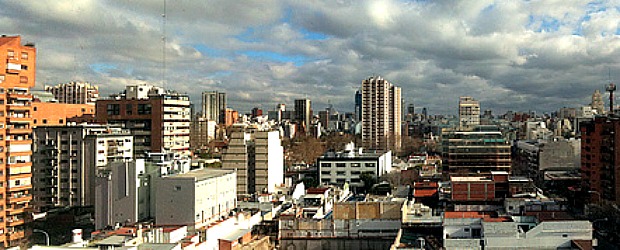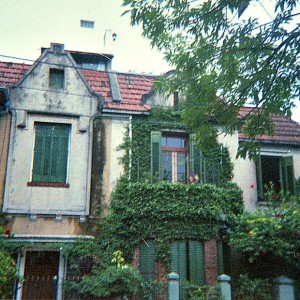You have no items in your cart. Want to get some nice things?
Go shopping
The old houses of Buenos Aires keep disappearing. At least that is how it always seems to me when I return to my adoptive barrio Belgrano, every year or so. As I wander up Avenida del Libertador, which carries traffic on its multiple lanes into and out of the heart of the city, I’m struck by sudden perplexing absences. This broad urban runway into the centre is a favourite for developers. Every time I gaze into the gleaming lobby of a brand new office block, with its adjacent branch of Starbucks and tidy basement garages, I feel myself profoundly disconcerted, not by the memory of what was once there, although this is sometimes the case, but more often than not by the puzzling absence of memory of what it was that once filled this or that space. Perhaps if I lived permanently in the barrio then the disconcertion wouldn’t be as profound. I would watch the old building being demolished and see the new one rising slowly in its place, towering far above the space where the roof or terrace of the old house, or shop, or cafe would once have been.
To return after a period of absence is an invitation to superimpose remembered streets over present streets, to constantly compare what is before our eyes with what is remembered. The curious thing is that when confronted with the sudden change, the dramatic new apartment building, the mirrored elevation of an office block, is that memory is lacking. As WH Hudson puts it in his memoir of an Argentine childhood, Far Away and Long Ago, ‘our memory serves and fools us’. What was once here? Was it a filling station or a cafe? A house of some sort? Several years ago I found myself drifting the streets seeking out old houses that looked ripe for redevelopment, with the intention that I might be able to photograph them, perhaps create an inventory of some kind. It is a ludicrous idea, of course, not least because I am not resident in the barrio for long enough to form any reliable record, but also because of the sheer volume of old barrio buildings that vanish from year to year. I occasionally see them, shrouded from roof to pavement in a fine black mesh, like a widow behind a veil, although I’ve never quite managed to work out whether this veil is there to protect the building, to keep out unwanted guests, or to protect the passerby from its slow decay and demolition. The more commonplace barrio houses or shops seem to go this way. These buildings, often single storey, seem impossibly romantic with their tall shuttered windows and the elaborate ironwork of their grilled doors. They fade, then vanish, the space an empty lot, by which time I am already struggling to recall what it once held, and then a year or two later something rises to fill the gap, a twenty-four hour parking garage or a residential tower.

To walk these streets after an absence of time is to encourage a meditation on the absences of space, to encourage a curious flânerie. Michel de Certeau in The Practice of Everyday Life relates memory and place by suggesting that ‘memory is a sort of anti-museum’ filled with presences that are absent and that ‘the places people live in are like the presences of diverse absences’. His famous distinction between place and space, the former being the localizable geographical entity, and the latter being the way we use and read place—‘space is a praticed place’—indicates that part of what we think of as urban space is the shifting connotations and associations we hold for it as individuals. ‘There is’—states de Certeau—‘no place that is not haunted by many different spirits hidden there in silence, spirits one can invoke or not’. The streets of Belgrano, like those of many other neighbourhoods in Buenos Aires, are haunted by these hidden spirits, by these diverse absences, and we can choose to invoke them, to trace them in some way that gives them meaning or purpose, or we can choose to ignore them. It strikes me that to try to walk and read these streets, to find some meaning in these absences and to relate what is no longer there to what is present, is like trying to read a palimpsest. Every street has been overwritten several times, sections of text have been scrubbed out, the blank spaces reused, the words jumbled together. And yet if you look hard enough a narrative emerges and traces of the past reappear. The survivors, such as an old barrio house hidden beneath the plasticized facade of a Carrefour Express, have not quite vanished. The text of the city continues to be written and rewritten in new ways, in the constant graffiti and street art that covers every available blank surface, even on the buildings that have been saved from destruction, such as the house of the sculptor Rogelio Yrurtia, now a museum housing his work and art collection.
This is a city which appears, from my own limited perspective, to struggle to retain and preserve its old buildings. In a recent visit to the closing down sale of a small private art gallery the owner told me that the building, a uniquely untouched colonial style house from the early 19th century, was totally unprotected from alteration or destruction. However, some buildings are being saved. Casa Mansilla, once the home of the writer, soldier, and politician, Luis V. Mansilla, has been deemed culturally and architecturally important enough to be preserved by the present government. The mansion sits on a quiet residential block, its back to the busy railway tracks that terminate at Retiro Station, and is home to a large colony of feral cats. Built in the Italian new-renaissance style, it was quite derelict when I first chanced upon it some eight years ago, its assorted outbuildings covered with street-art and its gardens overgrown. It seemed as though it too would fall into ruin and be ‘developed’. Then, a few visits ago, I noticed that a large metal wall had been erected across its frontage to prevent entry (this also now covered in street-art, but at that time in tidy navy blue paint), along with a government notice regarding the building’s preservation and restoration. The mansion remains dilapidated and has been subject to a legal battle over its ownership. Despite this, I feel some relief that it hasn’t fallen victim to a wrecking ball as yet.
And so I find myself continuing to walk Buenos Aires, struggling to fill the absences evoked by the presence of the streets around me, memories that I—foreigner, stranger—could not possibly have had, and in attempting to read these absences, give them some coherence, and try to invoke these hidden spirits. In a country that is still struggling to come to terms with its recent past, with the memories of more painful disappearances, an appreciation of and preservation of places, ‘the presences of diverse absences’, might be a fruitful way of negotiating the difficult narratives that emerge from trauma. It is telling then, that the former School for Naval Mechanics (ESMA), once a clandestine centre of detention and torture, is now preserved as the Space for Memory and Human Rights (Espacio Memoria Y Derechos Humanos). ‘Nothing is ever blotted out’, suggests WH Hudson, but the difficult process of recalling painful memories might benefit from such architectural jogging.

About Iain Robinson
Iain Robinson is an academic and writer living in the East of England. His debut novel The Buyer is published by CoLiCo Press. He has recently had articles published on novels by Sarah Hall and Will Self. Iain is currently represented by Litro's bespoke literary agency, Litro Represents.



